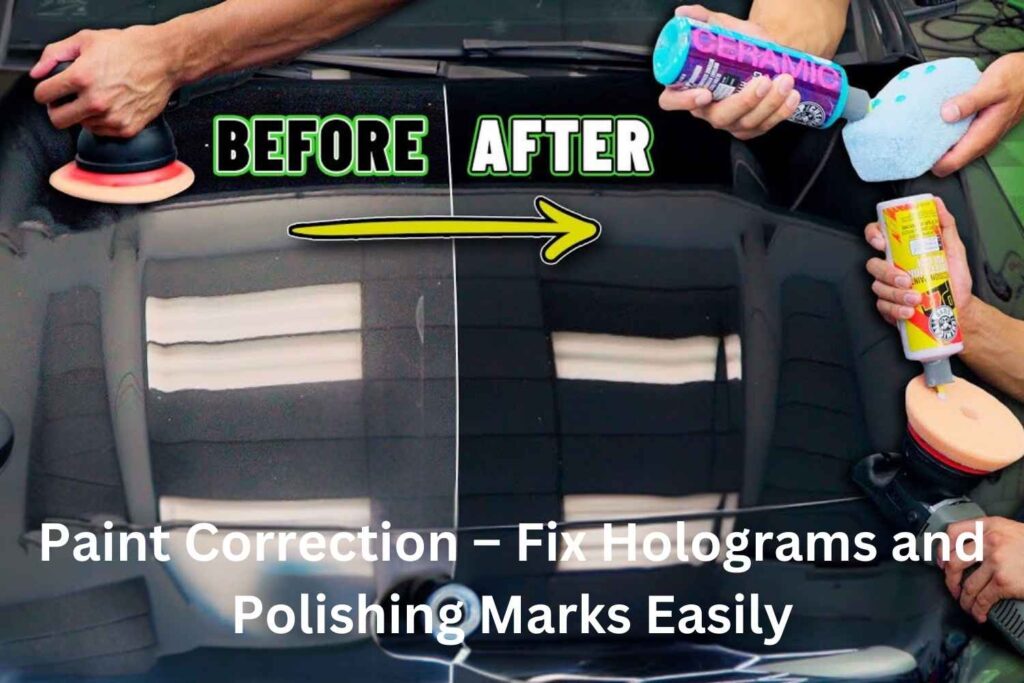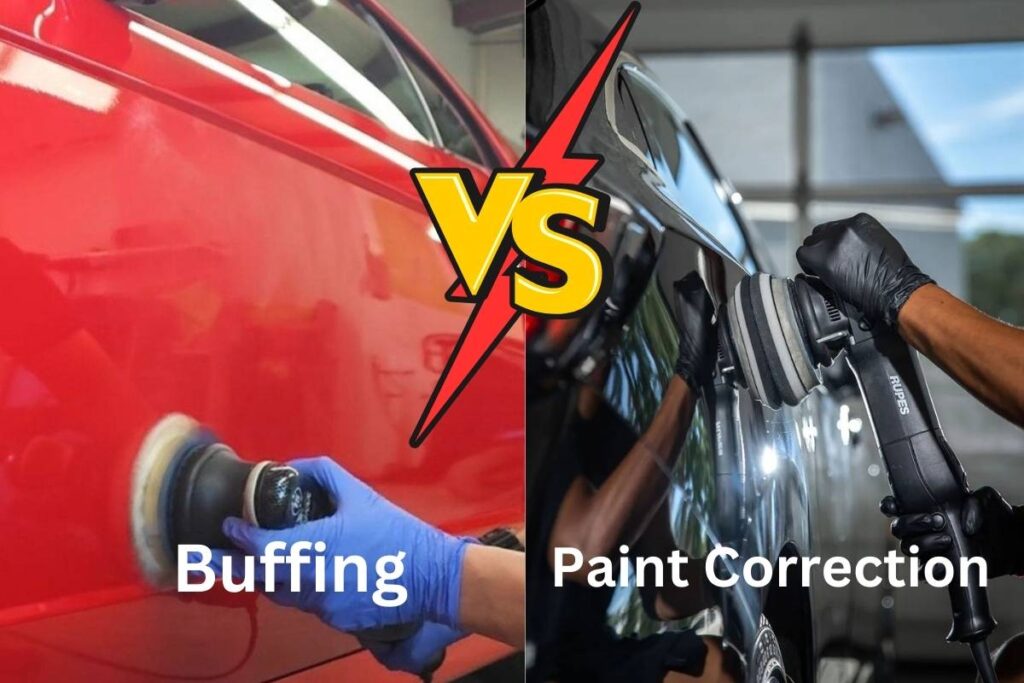Have you noticed scratches or dullness on your car’s paint? These imperfections can take away the beauty of your vehicle. Restoring that shine and smooth finish is easier than you think.
2 Step Paint Correction is a proven method to fix paint damage and bring back the car’s original look. This process removes scratches, swirl marks, and other flaws while improving the shine. It works for cars with moderate to severe paint problems.
In this blog, you will learn everything about 2 Step Paint Correction. From how it works to the benefits it offers, this guide will give you clear and simple answers. By the end, you’ll know if this process is right for your car and how to get the best results.
Table of Contents
ToggleWhat Is 2 Step Paint Correction?
Car paint faces many challenges. Small scratches, swirl marks, and oxidation are common problems. These issues make the surface dull and uneven. They can also affect the overall appearance of the vehicle.
Swirl marks often come from improper washing or drying. Dirt trapped in a cloth or sponge leaves fine scratches behind. Oxidation happens when the paint reacts with air over time. It makes the paint lose its shine and look cloudy. Deeper scratches can occur due to accidental bumps or contact with rough objects.
2 Step Paint Correction is a process to fix these imperfections. It removes these problems and restores the paint to its original state. Fixing these issues makes the car look fresh and well-maintained.
Each car has a unique paint condition. Some have minor defects, while others need more work. Understanding the problem helps in deciding the right method to correct it. Using the right tools and techniques is key to achieving the best results.
The 2 Step Paint Correction Process
2 Step Paint Correction involves two main stages. Each stage plays an important role in improving the paint’s condition.
Step 1: Compounding
The first step removes deep scratches and heavy defects. Compounding uses an abrasive product to cut through the clear coat layer. This step smooths out rough areas on the paint’s surface. It also reduces visible damage like swirl marks, oxidation, and other imperfections.
A dual-action polisher or rotary machine is often used in this step. These tools apply the compound evenly, giving better results. Different pads and compounds suit different levels of damage. A professional may assess the paint first to pick the right materials. This step fixes most visible flaws but may leave the surface slightly hazy.
Step 2: Polishing
The second step restores shine and clarity. Polishing removes the haze left from compounding. It refines the surface and enhances the depth of the paint. This stage also prepares the paint for sealants or protective coatings.
Polishing requires a softer pad and a less abrasive product. The goal is to create a smooth and glossy finish. This step completes the 2 Step Paint Correction process by making the paint look clean and vibrant. It brings back the car’s original beauty.
This method works best for cars with moderate to heavy paint damage. A professional approach ensures better results, but skilled DIY enthusiasts can try it with the right tools.
Benefits of 2 Step Paint Correction for Your Car
2 Step Paint Correction offers many advantages. It improves the car’s appearance and protects the paint.
One major benefit is the removal of visible defects. Scratches, swirl marks, and other imperfections fade away. This process gives the car a smooth and flawless surface. The result is a cleaner and more attractive finish.
It also restores the shine and depth of the paint. Cars with dull or faded paint look fresh again after this process. Polishing in the second step enhances the paint’s clarity and vibrancy. This makes the color stand out and look more vibrant.
The process prepares the surface for protective coatings. Applying a ceramic coating or sealant after the correction helps preserve the results. These layers protect the paint from future damage like UV rays, dirt, and water spots.
A well-maintained paint job improves the car’s value. Buyers often prefer cars with a clean and polished finish. 2 Step Paint Correction helps maintain the car’s market appeal over time.
Regular detailing after this process keeps the paint in good condition. This ensures the car continues to look its best.
When Is 2 Step Paint Correction Necessary?
2 Step Paint Correction is not always needed. It depends on the condition of the car’s paint. Minor imperfections may not require this detailed process.
Cars with moderate to severe defects benefit most from it. Swirl marks, oxidation, and visible scratches are common signs that this process is needed. These issues make the surface rough and uneven. A simple polish or wax cannot fix these problems.
It works well for cars with older or neglected paint. Time and exposure to the elements can damage the surface. Deep cleaning and compounding remove the build-up and restore the paint.
This method also suits cars with noticeable fading or dullness. Paint loses its shine due to sunlight and wear. Polishing in the second step revives the color and clarity.
1-step paint correction can work for minor defects. 2 Step Paint Correction is better for vehicles with heavier damage. It delivers a deeper level of cleaning and restoration.
Every car is different. Assessing the paint helps decide the right approach. Professionals often inspect the surface to recommend the best solution. This process ensures the car gets the care it needs.
Should You Try DIY 2 Step Paint Correction or Hire a Professional?
2 Step Paint Correction can be done at home or by a professional. Both options have their advantages. The choice depends on the tools, skills, and time available.
DIY paint correction costs less. You can buy the necessary products and tools. A polisher, cutting compound, and polishing pads are basic requirements. This option works best for minor defects or light scratches. People who enjoy car detailing often try this method. It allows more control over the process.
Professionals bring experience and advanced tools. They handle complicated cases like deep scratches or heavy oxidation. Their expertise ensures better results. They also use high-quality products that are not always available in regular stores.
DIY methods need careful handling. Mistakes like using the wrong pad or applying too much pressure can damage the paint. Professionals reduce this risk by knowing how to work with different paint types and conditions.
Time is another factor. DIY projects take longer to complete. Professionals finish the process faster and with better accuracy. For people with limited time or experience, professional services are often the better choice.
2 Step Paint Correction requires attention to detail. Deciding between DIY or professional service depends on the car’s condition and your confidence in handling the tools. Both options improve the paint’s appearance, but professionals often achieve a flawless finish.
Best Practices to Maintain Your Car After 2 Step Paint Correction
2 Step Paint Correction makes the car’s paint look fresh and smooth. To keep the results lasting longer, proper care is essential. This prevents new scratches and helps maintain the shine.
Protective coatings like ceramic coatings or paint sealants work best after the process. These coatings shield the paint from UV rays, dirt, and water spots. Wax can also add a temporary layer of protection but may need reapplication every few months.
Washing the car properly helps maintain the finish. Use a microfiber wash mitt and a two-bucket system. This method prevents dirt from scratching the surface. Avoid automatic car washes with harsh brushes. They often cause new swirl marks.
Drying the car with a clean microfiber towel also protects the paint. Letting water dry on its own can leave spots or streaks. These small steps preserve the smooth surface created by 2 Step Paint Correction.
Regular detailing keeps the car looking its best. A light polish every six months can help remove minor imperfections. Checking the condition of the protective coating also ensures lasting results.
Good habits extend the benefits of 2 Step Paint Correction. Protecting and maintaining the paint ensures the car stays shiny and vibrant for a long time.
Conclusion
2 Step Paint Correction is an effective way to restore the look of a car’s paint. It removes scratches, swirl marks, and other imperfections. The process also brings back the shine and depth of the paint. This makes the car look fresh and well-maintained.
Compounding and polishing work together to fix the paint. These steps smooth out the surface and create a glossy finish. The results last longer with proper care. Protective coatings, careful washing, and regular maintenance keep the paint looking great.
Professional services deliver excellent results. DIY options work well for minor defects with the right tools and skills. Both methods can improve the car’s appearance and value.
This method is perfect for cars with moderate to severe damage. It is a proven way to protect the paint and enhance its beauty. Anyone interested in improving their vehicle’s look can benefit from 2 Step Paint Correction.
Frequently Asked Questions (FAQs)
Is 2 Step Paint Correction safe for my car?
Yes, when done correctly. It removes a thin layer of clear coat to fix imperfections. Professional service ensures safety.
Can I do 2 Step Paint Correction myself?
Yes, with the right tools and knowledge. However, without experience, there’s a risk of damaging the paint. Professional help is often recommended.
How long does 2 Step Paint Correction take?
Typically, 6 to 12 hours. The exact time depends on the car’s size and the paint’s condition.
How much does 2 Step Paint Correction cost?
Prices vary based on location and vehicle condition. On average, expect to pay between $400 and $1,000.







